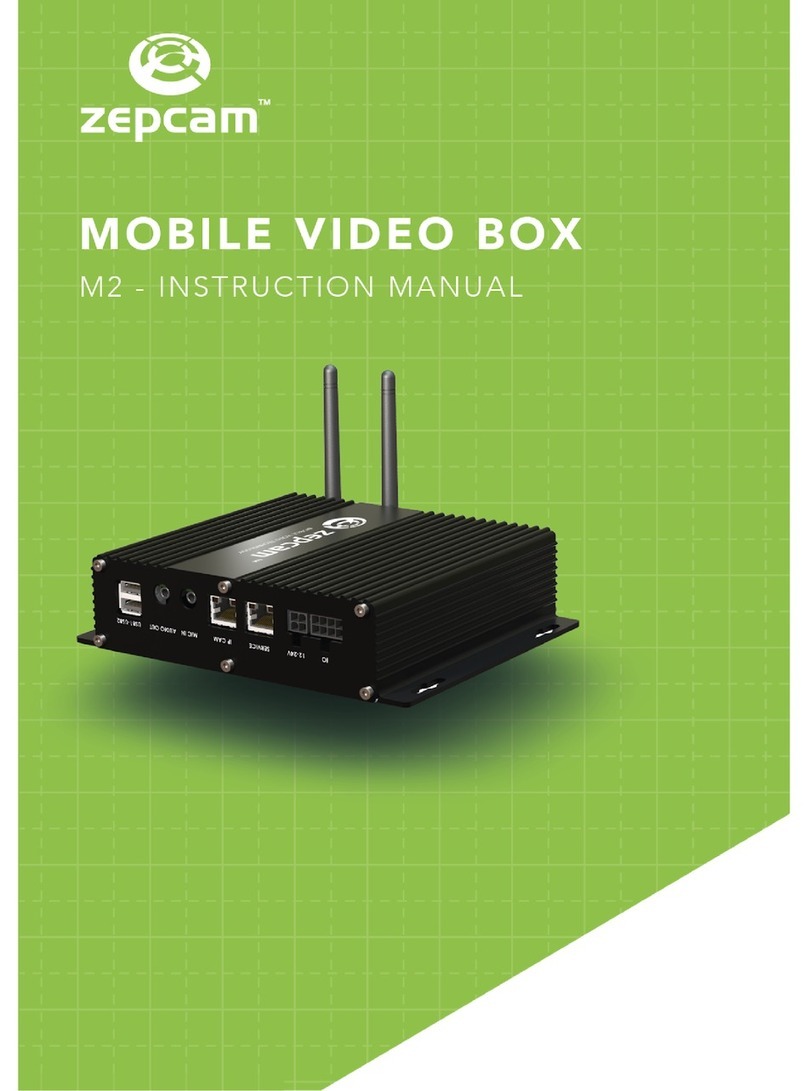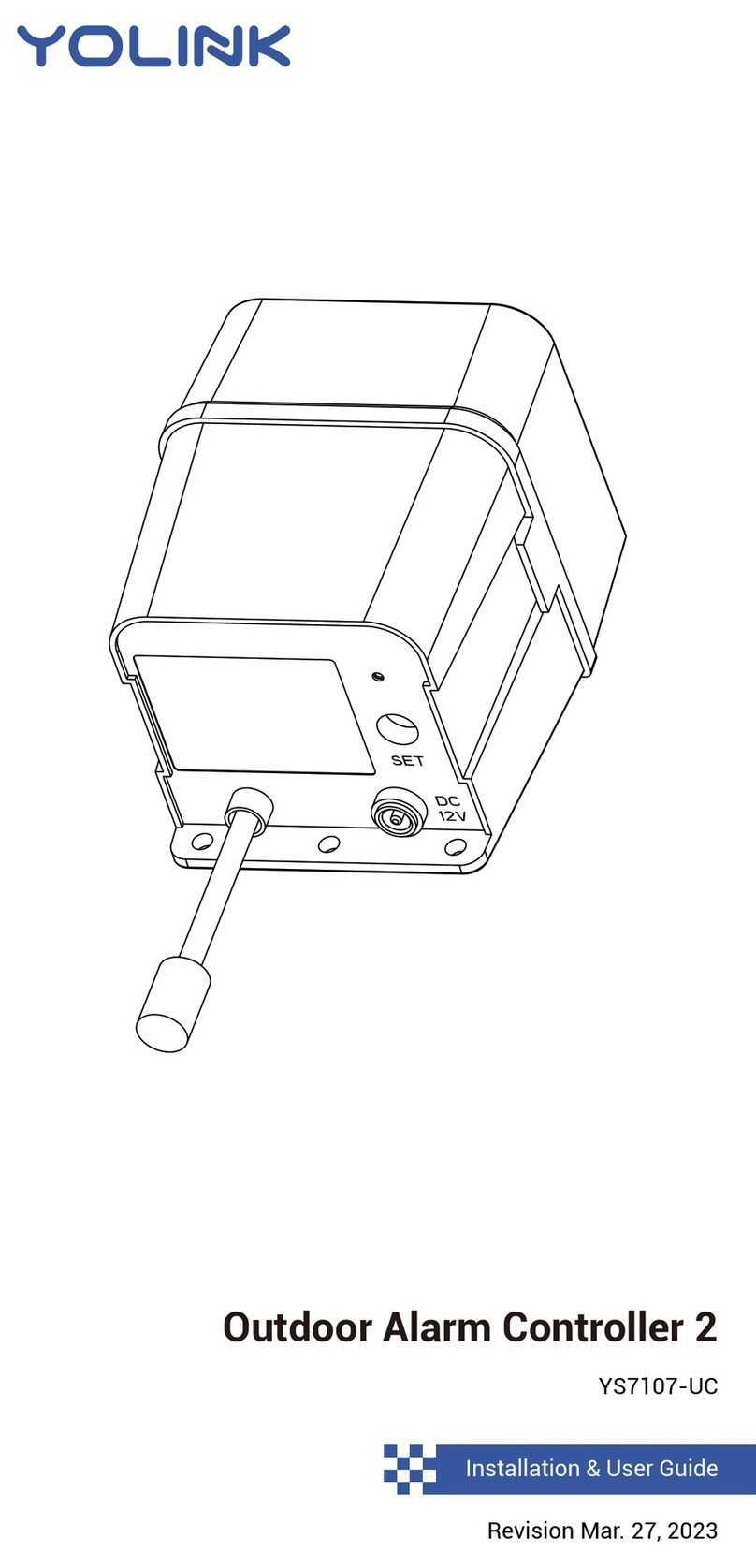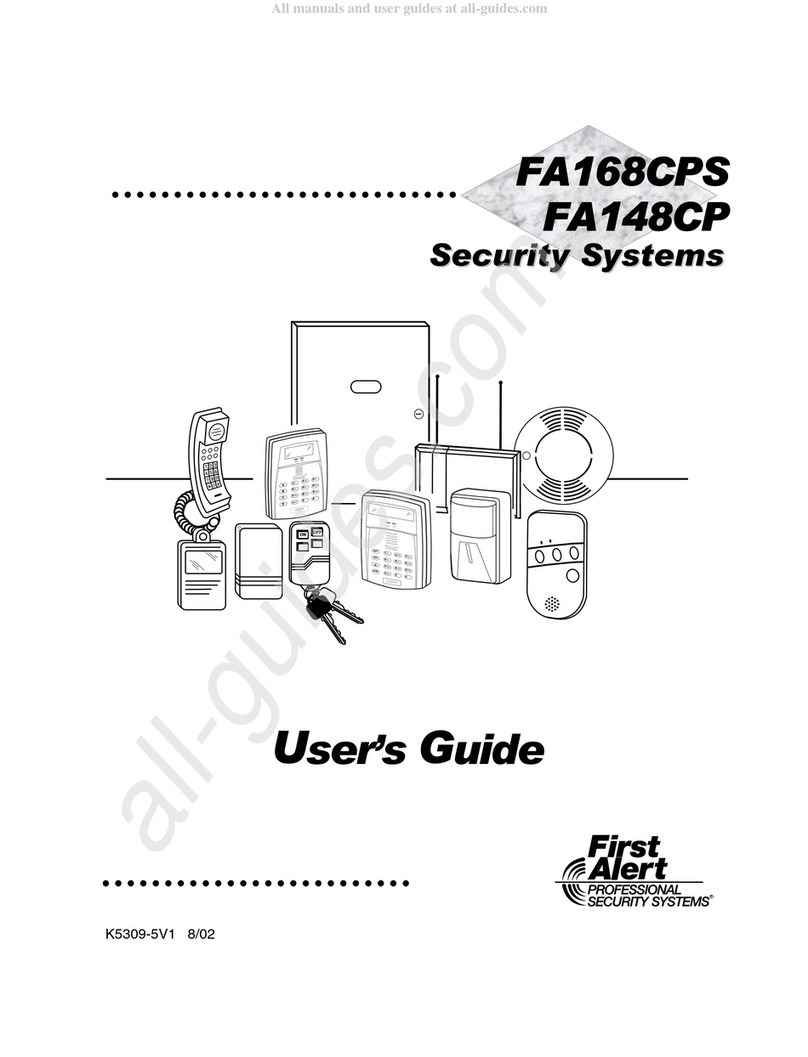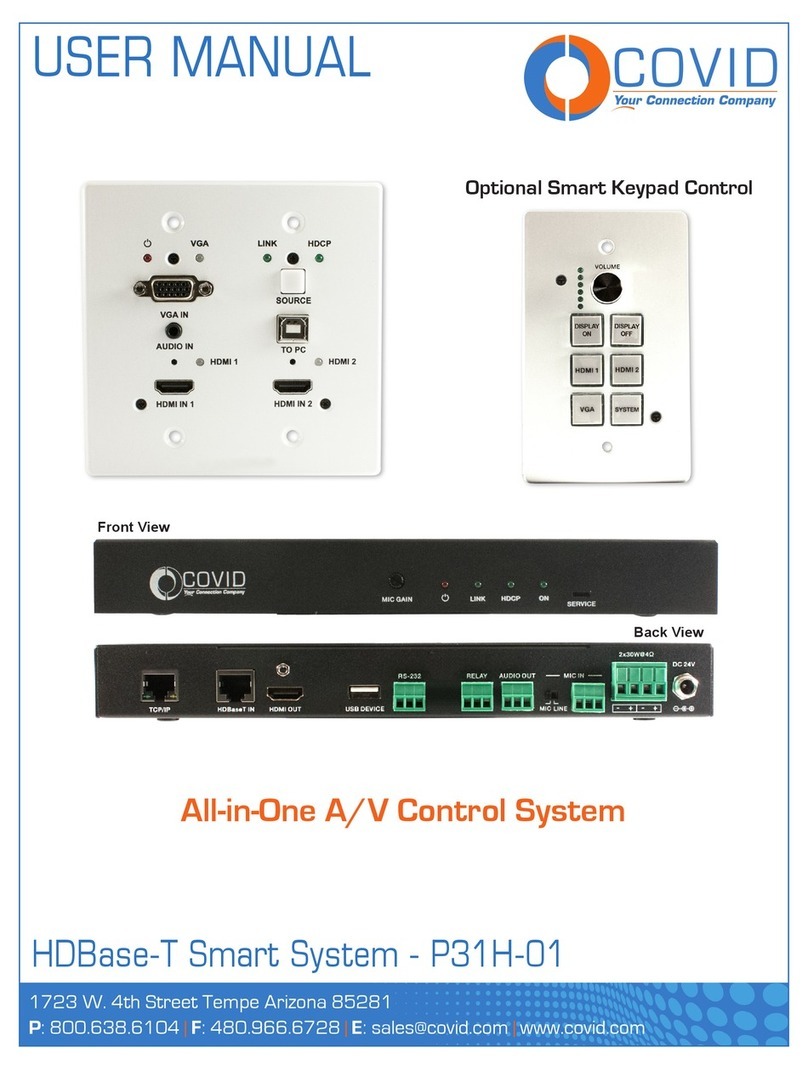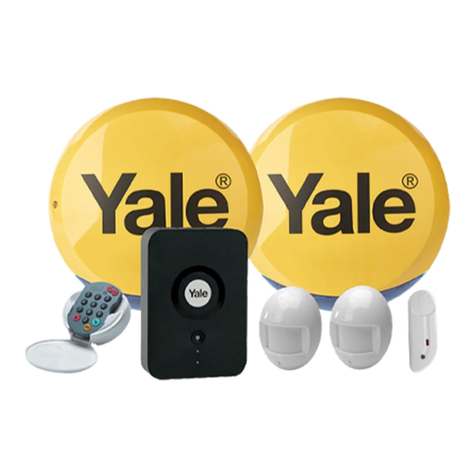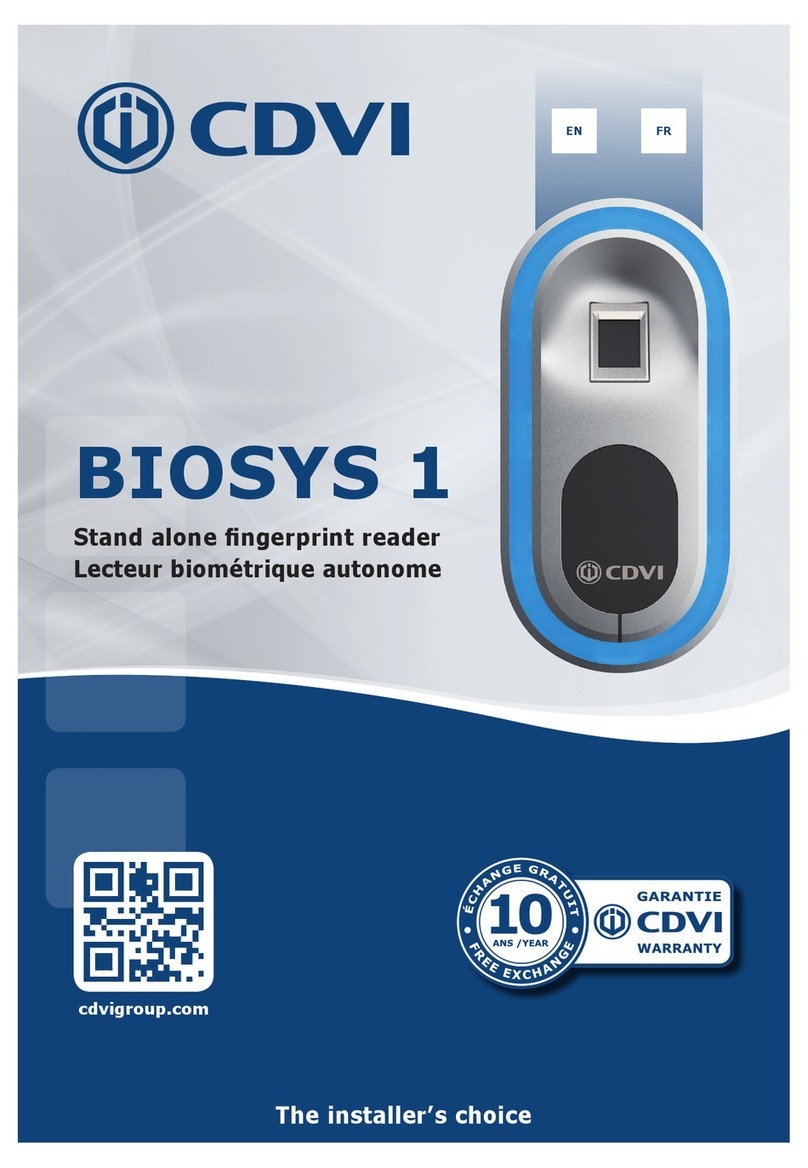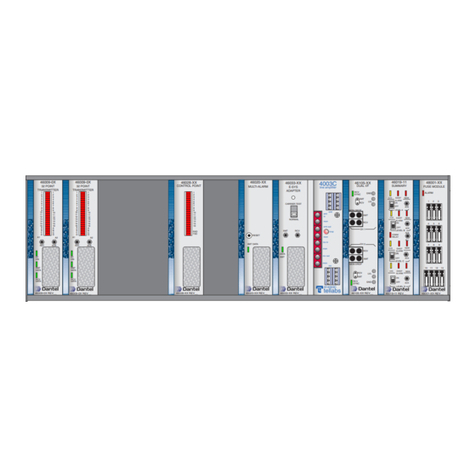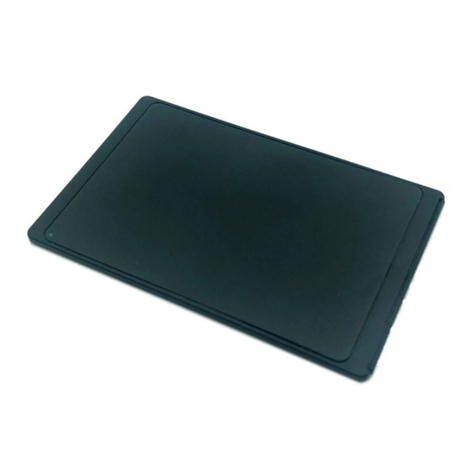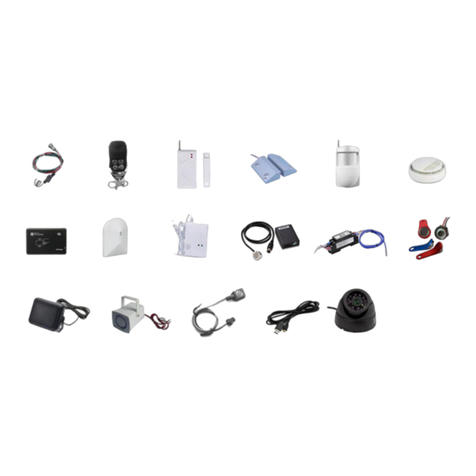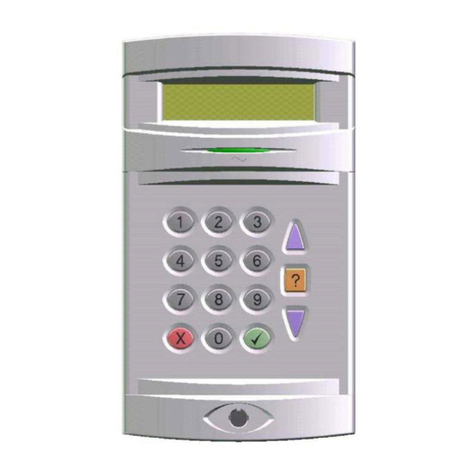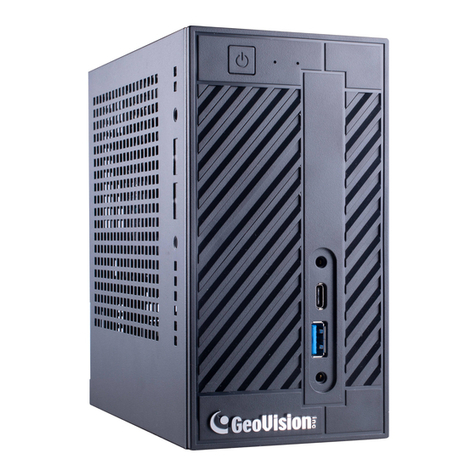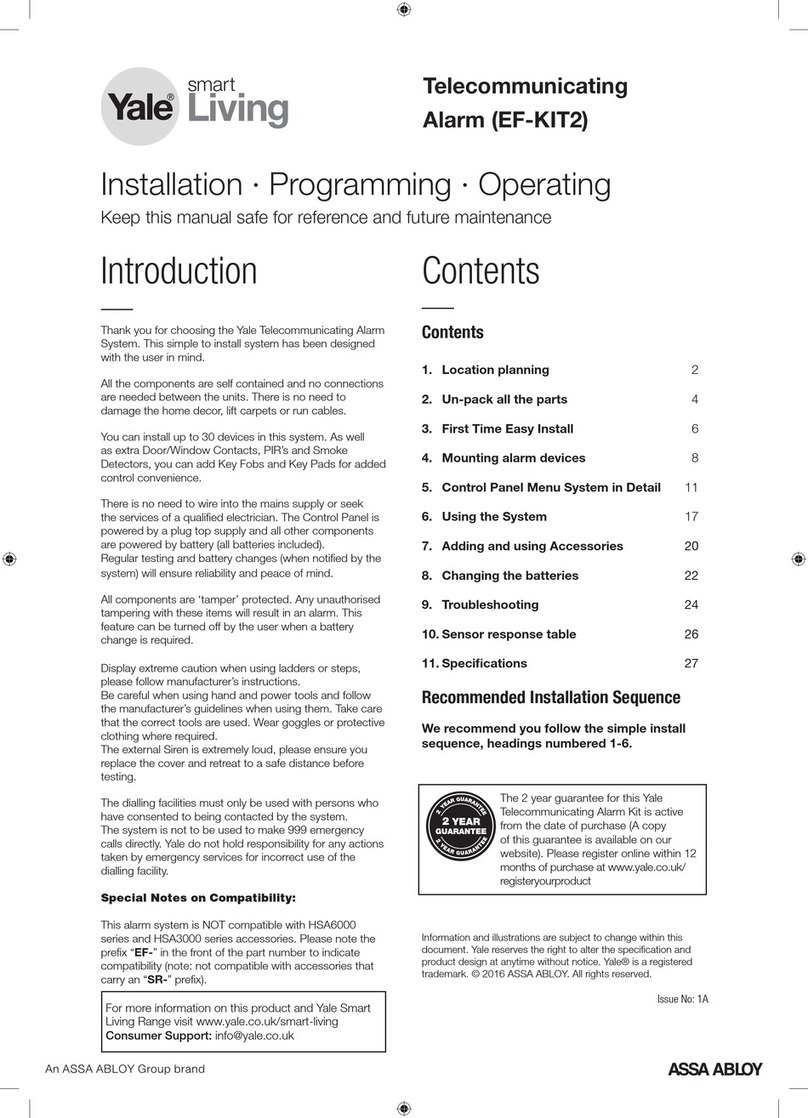RLE Technologies SeaHawk LDRA6 User manual

RLE TECHNOLOGIES
LDRA6 USER GUIDE

©2008 RLE Technologies 110046 Rev 1.6 (08/2008)

SEAHAWK LDRA6

©2008 RLE Technologies 110046 Rev 1.6 (08/2008)
PRODUCT REGISTRATION
Product registration helps RLE Technologies inform owners of:
•Product Upgrades
•Firmware Enhancements
•New products and Technologies
•Special Offers Available Only to Registered Users
Submit registration information on the Support/Product Registration webpage at www.rletech.com.
**Any information provided to RLE Technologies through the registration form will be regarded as confidential.
To read our Privacy Policy, please visit our website: rletech.com
TECHNICAL SUPPORT
Personal assistance is available Monday through Friday, from 8:00 a.m. to 5:00 p.m. MST.
For more information, please visit the Documentation/Files section on the
LDRA6 webpage of our website at www.rletech.com.
Otherwise, please call us directly at: (970) 484-6510 - press “2” for technical support
The following information is located on the bottom of each LDRA6 unit.
Please have this information available whenever a technical support call is placed:
Product Model Number _____________________________________________________
Product Serial Number _____________________________________________________
Product Manufacture Date ___________________________________________________

User Guide: LDRA6 Table of Contents
www.rletech.com 970 484-6510 i
TABLE OF CONTENTS
Chapter 1: Product Overview ........................................................................................................................................2
1-1
Description ......................................................................................................................................................2
1-2
LDRA6 Front Panel Indicators .......................................................................................................................2
1-2.1
Zone LEDs ...........................................................................................................................................2
1-2.2
Power LED...........................................................................................................................................2
1-2.3
Audible Alarm......................................................................................................................................2
1-2.4
Quiet/Test/Reset Switch.......................................................................................................................2
Chapter 2: Connections & Settings ...............................................................................................................................4
2-1
LDRA6 Board .................................................................................................................................................4
2-1.1
TB1 – Power ........................................................................................................................................5
2-1.2
POW1 – Power.....................................................................................................................................5
2-1.3
TB2, TB3 – Zone Inputs.......................................................................................................................5
2-1.4
TB5, TB4 – Zone Alarm Relays...........................................................................................................5
2-1.5
TB6 - Summary Relay..........................................................................................................................6
2-1.6
TB7 – RS485 Connection.....................................................................................................................6
2-2
SW1 - Relays and Alarm.................................................................................................................................7
2-2.1
SW1, Position 1: Summary Relay Supervised / Unsupervised ............................................................7
2-2.2
SW1, Position 2: Relays Latched / Unlatched......................................................................................7
2-2.3
SW1, Position 3: Zone Relay Linkage .................................................................................................7
2-2.4
SW1, Position 4: Zone Relays Supervised / Unsupervised ..................................................................7
2-2.5
SW1, Positions 5: Leak Alarm Delay...................................................................................................7
2-2.6
SW1, Positions 6: Summary Relay Silence-Ability .............................................................................7
2-2.7
SW1, Positions 7 and 8: Re-alarm Time ..............................................................................................8
2-3
SW2 – Modbus Addressing.............................................................................................................................8
2-4
SW4 through Sw9 ...........................................................................................................................................8
2-5
R1 – Leak Detection Cable Sensitivity Setting ...............................................................................................8
Chapter 3: Installation ...................................................................................................................................................9
3-1
Before You Begin ...........................................................................................................................................9
3-2
Connecting the Water Leak Detection Cable ..................................................................................................9
3-2.1
Secure the Cable to the Floor ...............................................................................................................9
3-2.2
Recommended Cable Installation.......................................................................................................10
3-3
Apply Power to the Unit ...............................................................................................................................11
3-3.1
Power via Wall Adapter .....................................................................................................................11
3-3.2
Power via Direct Line.........................................................................................................................11
Chapter 4: Start-Up......................................................................................................................................................12
4-1
Boot-Up.........................................................................................................................................................12
4-2
Displaying the Help Menu ............................................................................................................................12
4-3
Function Commands .....................................................................................................................................13
4-3.1
c – Contact Closure Settings ..............................................................................................................13
4-3.2
ld – Leak Delay Setting......................................................................................................................13
4-3.3
sens – Leak Zone Sensitivity..............................................................................................................13
4-3.4
e – View Eeprom Data .......................................................................................................................14
4-3.5
er – Erase Eeprom Data – Restores Factory Defaults.........................................................................14
4-3.6
mbb – View / Change Modbus Baud Rate .........................................................................................14
4-3.7
mbp – View / Change Modbus Parity ................................................................................................14
4-3.8
mr – Reset Modbus Port and Statistics...............................................................................................14
4-3.9
m – View Modbus Port Settings and Statistics...................................................................................14
4-3.10
t – Toggle Modbus Trace On/Off.......................................................................................................15
4-3.11
z – Display Leak Zone Readings........................................................................................................15
4-3.12
sr – summary relay mode ...................................................................................................................15
4-3.13
zr – zone relay mode ..........................................................................................................................15
4-3.14
x – Exit to Bootloader ........................................................................................................................15

Table of Contents User Guide: LDRA6
ii 970 484-6510 www.rletech.comii
Appendix A: Modbus Communications ..................................................................................................................... 16
A-1
Modbus Implementation of the LDRA6....................................................................................................... 16
A-1.1
Modes of Transmission ..................................................................................................................... 16
A-1.1.1
Slave Address Field ................................................................................................................ 16
A-1.1.2
Function Field ......................................................................................................................... 16
A-1.1.3
Data Field................................................................................................................................ 16
A-1.1.4
Error Check Field.................................................................................................................... 16
A-2
Packet Communications for the LDRA6...................................................................................................... 17
A-2.1
Read Output Registers ....................................................................................................................... 17
A-2.2
Read Input Registers.......................................................................................................................... 18
A-2.3
Present Single Register...................................................................................................................... 19
A-2.4
Present Multiple Registers................................................................................................................. 19
A-3
RTU Framing ............................................................................................................................................... 20
A-4
Modbus Mirroring ........................................................................................................................................ 21
Appendix B: Troubleshooting .................................................................................................................................... 22
Appendix C: Technical Specifications........................................................................................................................ 23

User Guide: LDRA6 List of Figures and Tables
www.rletech.com 970 484-6510 iii
LIST OF FIGURES AND TABLES
Figure 1-1: LDRA6 Front Panel Indicators ..................................................................................................................3
Figure 2-1: LDRA6 Board............................................................................................................................................4
Figure 3-1: Water Leak Detection Cable......................................................................................................................9
Figure 3-2: Cable Installation Methods ......................................................................................................................10
Table 1: Read Output Registers Packet Structure.......................................................................................................17
Table 2: Output Registers...........................................................................................................................................17
Table 3: Read Input Registers Packet Structure .........................................................................................................18
Table 4: Input Registers..............................................................................................................................................18
Table 5: Status Flags (Register 30001).......................................................................................................................18
Table 6: Status Flags (Register 30008).......................................................................................................................19
Table 7: Present Single Register Packet Structure......................................................................................................19
Table 8: Present Multiple Registers Packet Structure .................................................................................................19
Table 9: Modbus Slave Address.................................................................................................................................20
Table 10: Query Sample.............................................................................................................................................20
Table 11: Response Sample........................................................................................................................................20

Chapter 1: Product Overview User Guide: LDRA6
www.rletech.com 970 484-6510 2
CHAPTER 1: PRODUCT OVERVIEW
1-1 DESCRIPTION
The LDRA6 is a complete monitoring system that detects and reports the presence of water and other
conductive liquids, as well as monitors dry contact alarm points. The LDRA6 couples SeaHawk Water
Leak Detection Cable (SC) with an advanced control head to monitor six individual zones. When a
conductive liquid comes in contact with the SC cable, an alarm sounds and the summary alarm relay and
zone relay activate. The LED that corresponds with the appropriate zone also illuminates and an audible
alarm is activated. Each LDRA6 input can also be configured to detect a dry contact’s change of state (NO
or NC) and annunciate the alarm on the front panel.
The LDRA6 is a supervised system - it continuously monitors the cable for leaks and cable integrity. A
cable break causes a cable fault indication. An alarm sounds and the appropriate zone relay and the
summary alarm relay activate. The appropriate LED changes to indicate a cable fault has occurred.
The dry contact relays in the LDRA6 may be configured as supervised or unsupervised (see section 2-2 for
configuration options). Each zone can be configured with unique, individual settings. When the user
specified alarm condition occurs, the LDRA6 activates the appropriate relay and alarm LED.
1-2 LDRA6 FRONT PANEL INDICATORS
1-2.1 Zone LEDs
One tri-color LED for each zone.
Default Leak Detection Cable Setting:
On solid and green for normal cable conditions.
Flashes quickly and turns red if a leak is detected in the zone.
Flashes quickly and turns yellow if a cable fault is detected in the zone.
On solid once an alarm is silenced.
Default Dry Contact Setting:
On solid and green for normal, non-alarm conditions.
Flashes quickly and turns red (by default) if an alarm condition is detected in the zone.
On solid once an alarm is silenced.
1-2.2 Power LED
On (green) as long as power is on.
1-2.3 Audible Alarm
Activates when an alarm condition is detected. Silenced with the Quiet/Test/Reset switch.
1-2.4 Quiet/Test/Reset Switch
During alarm, the audible alarm is silenced, and any LED(s) in alarm will glow solidly. If the alarm goes
away, the LED(s) will flash slowly. Hold down the Quiet/Test/Reset switch to reset all alarms and
complete and self test cycle. If any alarms still exist, the unit will not reset the corresponding zones.
NOTE
:
The LDRA6 produces an alarm in the following conditions:
Leak Detected
Cable Fault
Dry Contact Alarm Condition (User Specified)

User Guide: LDRA6 Chapter 1: Product Overview
3 970 484-6510 www.rletech.com
Figure 1-1: LDRA6 Front Panel Indicators
Leak /Cable Detected LEDs
Power LED
Test / Reset/ Silence Switch

Chapter 2: Product Overview User Guide: LDRA6
www.rletech.com 970 484-6510 4
CHAPTER 2: CONNECTIONS & SETTINGS
2-1 LDRA6 BOARD
The LDRA6’s zone connectors, labeled TB2, are found at the bottom of the board on the double-stacked
terminal block. The switches on the board are labeled SW1 and SW2. The unit has one dial, labeled R1,
which is used to manually adjust the sensitivity for all zones. Sensitivity for individual zones may be
configured through the LDRA6’s RS232 Craft Port configuration, labeled P2. The switches for
configuring Dry Contact or Leak Detection monitoring for zones are labeled SW4 through SW9.
Figure 2-1: LDRA6 Board
R1
Leak Sensitivit
y
TB1
Power
POW1
Power
TB2
Zone
TB3
Zone
TB4
Zone
Alarm
Relays
TB5
Zone
Alarm
Relays
TB6
Summary
Relay
TB7
RS485
P2
RS232
SW4 – SW9
Zone
Configuration

User Guide: LDRA6 Chapter 2: Connections & Settings
5 970 484-6510 www.rletech.com
2-1.1 TB1 – Power
The LDRA6 connects to a 24VDC power supply using TB1, a two position connector labeled 24VDC.
2-1.2 POW1 – Power
Power can also be supplied to the unit through POW1. This is a wall adapter plug connection. This also
requires 24VDC.
2-1.3 TB2, TB3 – Zone Inputs
SeaHawk Leak Detection Cable (SC) and/or dry contact wires connect to the LDRA6 through TB2. Fifteen
foot (4.57m) leader cables (one is included in each leader cable kit, part #LC-KIT) are required for leak
detection cable connections only. Dry contact wires must be user supplied or may be supplied with your
dry contact device. Connect cables/wires as follows:
Position Leak Detection Cable Dry Contact Wire
TB3-1 Zone 1 White Zone 1 Input-1
TB3-2 Zone 1 Black Zone 1 Input-2
TB3-3 Zone 1 Green N/A
TB3-4 Zone 1 Red N/A
TB3-5 Zone 2 White Zone 2 Input-1
TB3-6 Zone 2 Black Zone 2 Input-2
TB3-7 Zone 2 Green N/A
TB3-8 Zone 2 Red N/A
TB3-9 Zone 3 White Zone 3 Input-1
TB3-10 Zone 3 Black Zone 3 Input-2
TB3-11 Zone 3 Green N/A
TB3-12 Zone 3 Red N/A
TB2-1 Zone 4 White Zone 4 Input-1
TB2-2 Zone 4 Black Zone 4 Input-2
TB2-3 Zone 4 Green N/A
TB2-4 Zone 4 Red N/A
TB2-5 Zone 5 White Zone 5 Input-1
TB2-6 Zone 5 Black Zone 5 Input-2
TB2-7 Zone 5 Green N/A
TB2-8 Zone 5 Red N/A
TB2-9 Zone 6 White Zone 6 Input-1
TB2-10 Zone 6 Black Zone 6 Input-2
TB2-11 Zone 6 Green N/A
TB2-12 Zone 6 Red N/A
2-1.4 TB5, TB4 – Zone Alarm Relays
These are the Zone Alarm Relay output terminal blocks (Form C). A status LED is located above each
relay, which will indicate the state of the relay (on/off). These relays can be configured as supervised or
unsupervised, latched or unlatched (unsupervised and unlatched by factory default). Connect the Zone
Alarm Relay wires to TB3 and TB4 as follows:
TB5-1 Zone 1 alarm relay normally open (NO)
TB5-2 Zone 1 alarm relay common (C)
TB5-3 Zone 1 alarm relay normally closed (NC)
TB5-4 Zone 2 alarm relay normally open (NO)
TB5-5 Zone 2 alarm relay common (C)
TB5-6 Zone 2 alarm relay normally closed (NC)

Chapter 2: Product Overview User Guide: LDRA6
www.rletech.com 970 484-6510 6
TB5-7 Zone 3 alarm relay normally open (NO)
TB5-8 Zone 3 alarm relay common (C)
TB5-9 Zone 3 alarm relay normally closed (NC)
TB4-1 Zone 4 alarm relay normally open (NO)
TB4-2 Zone 4 alarm relay common (C)
TB4-3 Zone 4 alarm relay normally closed (NC)
TB4-4 Zone 5 alarm relay normally open (NO)
TB4-5 Zone 5 alarm relay common (C)
TB4-6 Zone 5 alarm relay normally closed (NC)
TB4-7 Zone 6 alarm relay normally open (NO)
TB4-8 Zone 6 alarm relay common (C)
TB4-9 Zone 6 alarm relay normally closed (NC)
2-1.5 TB6 - Summary Relay
This is the Summary Relay output terminal block (Form C). A status LED is located to the right of the
relay, which will indicate the state of the relay (on/off). This relay can be configured as supervised or
unsupervised, latched or unlatched. Connect the Summary Relay wires to TB5 as follows:
TB6-1 Summary alarm normally open (NO)
TB6-2 Summary alarm common (C)
TB6-3 Summary alarm normally closed (NC)
2-1.6 TB7 – RS485 Connection
The LDRA6 can communicate with other devices through the RS485 terminal block. Wire as follows:
TB7-1 + or A wire
TB7-2 – or B wire
TB7-3 Shield or GND wire

User Guide: LDRA6 Chapter 2: Connections & Settings
7 970 484-6510 www.rletech.com
2-2 SW1 - RELAYS AND ALARM
2-2.1 SW1, Position 1: Summary Relay Supervised / Unsupervised
Configures the Summary Alarm relay as supervised or unsupervised. If a relay is supervised, the relay
picks until power goes off or until an alarm is detected. The alarm then releases to announce a change in
state. An unsupervised relay picks only when an alarm is detected.
1 = Supervised
0 = Unsupervised (factory default)
2-2.2 SW1, Position 2: Relays Latched / Unlatched
Configures all relays as latched or unlatched. If a relay is latched, the relay will remain in an alarm
condition until the Reset switch is pressed. If a relay is unlatched, the relay will remain in alarm until
either the Reset switch is pressed, or the condition that tripped the relay goes away.
1 = Latched
0 = Unlatched (factory default)
2-2.3 SW1, Position 3: Zone Relay Linkage
Configures all Zone Alarm Relays to link together and pick simultaneously upon alarm. When this switch
is turned on, if a zone goes into alarm, all six zone alarm relays and the summary alarm relay will pick.
When this switch is turned off, if a zone goes into alarm, only the zone alarm relay for the zone that is in
alarm and the summary alarm relay will pick.
1 = Individual Zone Alarm Relays Linked
0 = Individual Zone Alarm Relays Not Linked (factory default)
2-2.4 SW1, Position 4: Zone Relays Supervised / Unsupervised
Configures the individual Zone Alarm Relays as supervised or unsupervised. If a relay is supervised, the
relay picks until power goes off or until an alarm is detected. The alarm then releases to announce a change
in state. An unsupervised relay picks only when an alarm is detected.
1 = Supervised
0 = Unsupervised (factory default)
2-2.5 SW1, Positions 5: Leak Alarm Delay
Designates the unit’s leak delay time. Setting this switch to off uses the default leak alarm delay of 15
seconds. Setting this switch to on designate the leak alarm delay to use the value specified through the
unit’s craft port.
1 = Leak Alarm Delay set through Craft Port
0 = Leak Alarm Delay set at 15 seconds (factory default)
2-2.6 SW1, Positions 6: Summary Relay Silence-Ability
Configures the Summary Alarm Relay as silence-able or not silence-able. If the Summary Alarm Relay is
silence-able, the relay returns to normal when the Quiet/Test/Reset button is pressed. If the Summary
Alarm Relay is not silence-able, the relay stays picked until the alarm condition is cleared.
1 = Summary Alarm Relay is Silence-Able
0 = Summary Alarm Relay is Not Silence-Able (factory default)

Chapter 2: Product Overview User Guide: LDRA6
www.rletech.com 970 484-6510 8
2-2.7 SW1, Positions 7 and 8: Re-alarm Time
Configures the unit’s re-alarm time. Set the switches as below for desired (approximate) re-alarm times:
1 1 = 24 hours
0 1 = 16 hours
1 0 = 8 hours
0 0 = Disabled; no re-alarming once silenced (factory default)
2-3 SW2 – MODBUS ADDRESSING
Configures the unit’s RS485 address. The unit’s address is set in bits and can range from 00000001 to
11111110 (1-254 in decimal notation).
00000000 = No Address (factory default)
00000001 = 1
00000010 = 2
00000011 = 3
…
11111101 = 253
11111110 = 254
2-4 SW4 THROUGH SW9
Configures each zone as a Leak Detection Cable input or a Dry Contact input. If configured as a Leak
Detection Cable input, the zone requires a 4-wire leak detection cable (SC) to monitor. If configured as a
Dry Contact input, the zone requires a 2-wire dry contact device to monitor. If any zone is not desired to be
used, set the zone to Dry Contact and normally open (factory default) to avoid unwanted alarms.
SW4 Up = Zone 1 is a Dry Contact input
SW4 Down = Zone 1 is a Leak Detection input
SW5 Up = Zone 2 is a Dry Contact input
SW5 Down = Zone 2 is a Leak Detection input
SW6 Up = Zone 3 is a Dry Contact input
SW6 Down = Zone 3 is a Leak Detection input
SW7 Up = Zone 4 is a Dry Contact input
SW7 Down = Zone 4 is a Leak Detection input
SW8 Up = Zone 5 is a Dry Contact input
SW8 Down = Zone 5 is a Leak Detection input
SW9 Up = Zone 6 is a Dry Contact input
SW9 Down = Zone 6 is a Leak Detection input
2-5 R1 – LEAK DETECTION CABLE SENSITIVITY SETTING
This potentiometer allows users to manually adjust the sensitivity setting for all six zones. Turn the dial
clockwise to make the zone less sensitive. This means a leak will be reported in that zone when a large
amount of water is present. Turn the dial counterclockwise to make the zone more sensitive. This means a
leak will be reported for the zone when a small amount of water is present.
This potentiometer can be overridden through the LDRA6’s craft port configuration for individual zones
(see section 4-3.3 for details).

User Guide: LDRA6 Chapter 3: Installation
9 970 484-6510 www.rletech.com
CHAPTER 3: INSTALLATION
3-1 BEFORE YOU BEGIN
The LDRA6 is a wall mounted device. To secure the device to the wall, first open the door of the
enclosure. There are knockouts on the top and bottom of the enclosure. Remove as many as necessary.
Use drywall anchors and the holes in the back of the enclosure to secure the unit to the wall.
3-2 CONNECTING THE WATER LEAK DETECTION CABLE
A leader cable kit (part #LC-KIT) is required per zone to connect the LDRA6 to SeaHawk Leak Detection
Cable (SC). A leader cable is included in each LC-KIT; one end of this leader cable connects into the
LDRA6. This end of the cable is finished with stripped, bare wires. The other end features a mating
connector which connects with the SC cable. The end of the cable zone requires a removable end
terminator (EOL) which is also included in a leader cable kit (LC-KIT).
To connect the leader cable to the LDRA6, connect the wires (4) to the appropriate zone position of the
terminal block connectors (see section 2-1.3 for more wiring details). Adjust the appropriate zone
configuration for Leak Detection input (see section 2-4 for more details).
Once the leader cable is plugged into the terminal block, it is ready to be connected to the SC cable. To do
this, unscrew the EOL terminator from the end of the leader cable. Attach the first length of SC cable to
the leader cable. Route the SC cable according to the cable layout diagram, if provided. Lay the cable
according to figure 3-1 and section 3-2.1. Secure the EOL terminator on the unoccupied end of the SC
cable.
Figure 3-1: Water Leak Detection Cable
3-2.1 Secure the Cable to the Floor
Secure the cable to the floor with either J-clips (part #JC) or one of the other approved methods shown in
Figure 3-2. J-clips are the manufacturer’s recommended installation method.
Place one J-clip every three feet along the length of the SC cable. Place one J-clip at each turn of
the cable.
NOTE
:
A Leader Cable Kit (part #LC-KIT) is required per zone to connect the LDRA6 to
SeaHawk Leak Detection Cable (SC). Each LC-KIT includes a 15 foot (4.57m) leader
cable and an EOL terminator. The kits are NOT included with the LDRA6, and can
be purchased separately.

Chapter 3: Product Overview User Guide: LDRA6
www.rletech.com 970 484-6510 10
If the cable is installed over an obstruction, clip the cable on both sides, as close to the obstruction
as possible.
Do not install the cable directly in front of an air conditioner. Allow a minimum of 6 feet (1.83m)
between the unit and the cable. If the SC cable is too close to the air conditioning unit’s air stream,
the moisture from the humidifier may cause false leak readings. If the cable must be installed in
front of an air conditioning unit, place the J-clips 12 to 18 inches (.305m to .457m)apart.
3-2.2 Recommended Cable Installation
Figure 3-2: Cable Installation Methods
NOTE
:
It is important to finish the end of the SeaHawk Leak Detection Cable (SC) with the
end-of-line terminator (EOL). If the EOL terminator is not present, a cable fault will
register. Note any variances between the cable layout diagram and the actual cable
installation. Wait approximately one minute. No alarm should be present.

User Guide: LDRA6 Chapter 3: Installation
11 970 484-6510 www.rletech.com
3-3 APPLY POWER TO THE UNIT
Once cable for all the desired leak detection zones has been connected to the unit, power may be applied.
The LDRA6 operates on 24VDC power supplied by a wall adapter or a direct line. A power supply should
be run to the location of the unit.
3-3.1 Power via Wall Adapter
The LDRA6 can be powered by a wall adapter. Before connecting the wall adapter to the LDRA6, unplug
the adapter from the wall. If the adapter has a connector on the end, feed the cord through one of the
knockouts in the enclosure and plug it directly into the 24VDC receptacle located at POW1. Plug the other
end of the adapter into the wall. The LDRA6 should power up immediately.
3-3.2 Power via Direct Line
If the adapter does not have a connector on the end, strip the end of the adapter line so the two wires inside
are exposed. Strip the end of each of the two wires and feed them into the enclosure. Insert the two wires
into the terminal block labeled TB1. The minus, or ground, wire is placed into the right opening in the
terminal block. The plus, or live, wire is placed into the left opening in the terminal block.
Once all the wires have been placed inside the terminal block, tighten the three screws across the bottom of
the terminal block until the wires are securely held in place. Plug the other end of the wall adapter into the
wall. The LDRA6 should power up immediately.

Chapter 4: Product Overview User Guide: LDRA6
www.rletech.com 970 484-6510 12
CHAPTER 4: START-UP
4-1 BOOT-UP
Make sure the RS-232 port is connected to a PC or terminal with a straight through cable. When the
LDRA6 is powered up, the boot ROM and flash program code are verified. Output similar to the screen
displayed below should appear on the terminal or terminal emulation software.
4-2 DISPLAYING THE HELP MENU
Once the system reaches this point, type? and press Enter to display the Help Menu. The Help Menu lists
the function commands for the LDRA6.
Help Menu – LDZ6/RASP6 V2.1
c - view/change CC settings
ld - view/change leak delay
sens – view/change leak zone sensitivity
e - view eeprom data
er - erase eeprom data – restores factory defaults
mbb - change modbus baud rate
mbp - change modbus parity
mr - reset modbus port/statistics
m - view modbus port settings/statistics
t - toggle modbus trace on/off
z - display leak zone readings
sr - summary relay mode
zr - zone relay mode
x - exit to bootloader
LDZ/Rasp6 Bootloader – LDZ6BOOT V2.1
Firmware Prgm Id: LDZ6/RASP6 V2.1
checksum valid
LDZ/Rasp6 bootup
LDZ6/RASP6 V2.1
Reading EEprom.......................................
..... ok
Modbus Addr:0 9600,8,N,1

User Guide: LDRA6 Chapter 4: Start-Up
13 970 484-6510 www.rletech.com
4-3 FUNCTION COMMANDS
4-3.1 c – Contact Closure Settings
c displays the current contact closure settings for each zone. To adjust a zone’s configuration, use the
following format: cX/type/offcolor/oncolor/delay
Xis the zone number and can range from 1-6 for each input.
type is the contact closure setting; use “no” for normally open, “nc” for normally closed, or “st”
for a status point.
off-color is the normal condition (non-alarm) LED color.
on color is the alarm condition LED color.
The colors for LEDs can be green, yellow or red.
delay is the number of seconds the alarm must be active before annunciated and can range from 0
to 999 seconds.
4-3.2 ld – Leak Delay Setting
ld displays the current leak alarm delay in seconds. This is the number of seconds the leak alarm must be
detected before annunciated. The leak alarm delay can range from 0 to 999 seconds.
Use the format ld/x where x is the number of seconds for the leak alarm delay.
This value applies to all zones configured for Leak Detection. SW1 position 5 determines if this RS232
configured value is used (see section 2-2.5).
4-3.3 sens – Leak Zone Sensitivity
sens displays the current leak detection sensitivity settings for each zone. The first value displayed is the
value read from R1, the sensitivity dial on the LDRA6 board. Each zone is displayed in the format x:
yyy/zzz, where x is the zone, yyy is the value currently being used for sensitivity (in micro amps read by
the sensing cable, yyy can range from 25 to 300), and zzz is the manually entered value through the craft
port (factory default is 0). Values shown below uses sensitivity set to High (fully counterclockwise).
Pot: 25 1:25/0 2:25/0 3:25/0 4:25/0 5:25/0 6:25/0
** 1: CC / 2: CC / 3: CC / 4: CC / 5: CC / 6: CC **
cX/type/offcolor/oncolor/delay
c1/no/green/red/0
c2/no/green/red/0
c3/no/green/red/0
c4/no/green/red/0
c5/no/green/red/0
c6/no/green/red/0

Chapter 4: Product Overview User Guide: LDRA6
www.rletech.com 970 484-6510 14
To override the manual sensitivity dial setting, enter a new value for each desired zone. Using a value of 0
will enable desired zone to use manual sensitivity dial setting. Use the format sensX/yyy to override a
zone’s setting. Example: sens1:300 sets Zone 1 to a sensitivity of 300 micro amps. Type sens and press
Enter again to viewing the Leak Zone Sensitivity settings after entering new value displays the following:
4-3.4 e – View Eeprom Data
This function is a reserved command used for advanced diagnostic purposes only.
4-3.5 er – Erase Eeprom Data – Restores Factory Defaults
er will erase all RS232 configured settings and restore them all to factory default values.
4-3.6 mbb – View / Change Modbus Baud Rate
mbb will display modbus address, baud rate, data bits, parity, and stop bits. Default values are displayed
below.
To change modbus baud rate, use the format mbb/xxxx where xxxx is the baud rate. Valid selections for
baud rate are 1200, 2400, 9600 and 19200.
4-3.7 mbp – View / Change Modbus Parity
mbp will display modbus address, baud rate, data bits, parity, and stop bits. Default values are displayed
below.
To change modbus parity rate, use the format mbp/x where x is the parity. Valid selections for parity are:
e – even
o – odd
n – none
4-3.8 mr – Reset Modbus Port and Statistics
mr will reset all RS485 Modbus counters.
4-3.9 m – View Modbus Port Settings and Statistics
m will display the current RS485 Modbus port settings and logged statistics. Initial values appear as:
Modbus Addr:0 9600,8,N,1
overruns: 0
parity_errors: 0
noise_errors: 0
framing_errors: 0
inpackets: 0
crc_errors: 0
for me: 0
not for me: 0
Modbus Addr:0 9600,8,N,1
Modbus Addr:0 9600,8,N,1
Pot:25 1:300/300 2:25/0 3:25/0 4:25/0 5:25/0 6:25/0
Table of contents
